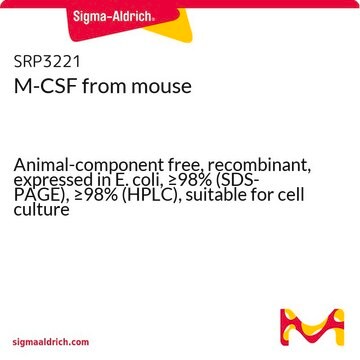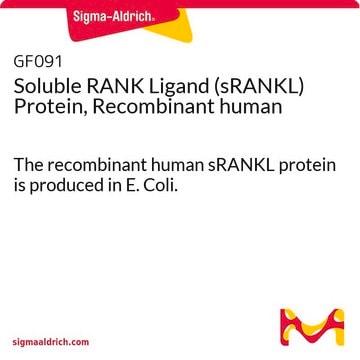T3573
RANK Ligand/TRANCE human
>90% (SDS-PAGE), recombinant, expressed in NSO cells, lyophilized powder
동의어(들):
Osteoclast Differentiation Factor (ODF), Osteoprotegerin Ligand (OPGL), Receptor Activator of NF-KB Ligand (RANKL), TNF-related activation-induced cytokines (TRANCE)
로그인조직 및 계약 가격 보기
모든 사진(1)
About This Item
추천 제품
생물학적 소스
human
Quality Level
재조합
expressed in NSO cells
분석
>90% (SDS-PAGE)
형태
lyophilized powder
효능
1.5-7.5 ng/mL ED50
분자량
glycolysylated recombinant product ~35 kDa by SDS-PAGE
calculated mol wt 23 kDa
포장
pkg of 10 μg
저장 조건
avoid repeated freeze/thaw cycles
불순물
endotoxin, tested
UniProt 수납 번호
응용 분야
cell analysis
저장 온도
−20°C
유전자 정보
human ... TNFSF11(8600)
관련 카테고리
일반 설명
Tumor necrosis factor (ligand) superfamily, member 11 (Tnfsf11) is also known as receptor activator of nuclear factor-κB ligand (RANKL). It is a type II transmembrane signaling receptor. It has a molecular weight of around 35kDa. This protein contains an amino-terminal intracellular tail and a carboxy-terminal extracellular region, that bears a connecting stalk and a receptor-binding domain. Tnfsf11 is located on human chromosome 13q14.11.
애플리케이션
RANK Ligand/TRANCE human can be used in in vitro osteoclastogenic assays for osteoclast differentiation.
RANK Ligand/TRANCE human has been used to stimulate differentiation.
생화학적/생리학적 작용
RANK Ligand (receptor activator of NF-kB ligand (RANKL) also referred to as TNF-related activation induced cytokines (TRANCE) or osteoprotegerin ligand is a protein that belongs to tumor necrosis factor (TNF) family. It stimulates the mature dendritic cells and induces the cytokine production. RANKL also facilitates bone remodelling and possess an angiogenic activity.
RANK Ligand/TRANCE, a member of the TNF superfamily, induces activation of the c-jun N-terminal kinase, enhances T-cell growth and dendritic cell function, induces osteoclastogenesis, and lymph node organogenesis. Mouse and human RANK Ligand share 85% amino acid identity. RANK is the cell surface receptor for RANK Ligand.
물리적 형태
Lyophilized from a 0.2 μm filtered solution in 20 mM MOPS and 500 mM NaCl, pH 6.5, with 50 μg BSA per 1 μg as a carrier protein.
분석 메모
The biological activity is measured by its ability to induce osteoclast differentiation on mouse splenocytes.
Storage Class Code
11 - Combustible Solids
WGK
WGK 3
Flash Point (°F)
Not applicable
Flash Point (°C)
Not applicable
개인 보호 장비
Eyeshields, Gloves, type N95 (US)
시험 성적서(COA)
제품의 로트/배치 번호를 입력하여 시험 성적서(COA)을 검색하십시오. 로트 및 배치 번호는 제품 라벨에 있는 ‘로트’ 또는 ‘배치’라는 용어 뒤에서 찾을 수 있습니다.
RANKL employs distinct binding modes to engage RANK and the osteoprotegerin decoy receptor
Nelson C A, et al.
Structure, 20(11), 1971-1982 (2012)
R Josien et al.
Journal of immunology (Baltimore, Md. : 1950), 162(5), 2562-2568 (1999-03-11)
TNF-related activation-induced cytokine (TRANCE) is a member of the TNF family recently identified in activated T cells. We report here that TRANCE mRNA is constitutively expressed in memory, but not naive, T cells and in single-positive thymocytes. Upon TCR/CD3 stimulation
Cytosolic phospholipase A2 and eicosanoids modulate life, death and function of human osteoclasts in vitro
Allard-Chamard H, et al.
Prostaglandins, Leukotrienes, and Essential Fatty Acids, 90(4), 117-123 (2014)
Soluble TRAIL is present at high concentrations in seminal plasma and promotes spermatozoa survival.
Giorgio Zauli et al.
Reproduction (Cambridge, England), 148(2), 191-198 (2014-05-16)
The expression of tumor necrosis factor-related apoptosis-inducing ligand (TRAIL(TNFSF10)) and of its receptors (TRAILR1, TRAILR2, TRAILR3, and TRAILR4) have been documented in testis, but the presence of soluble TRAIL in seminal fluid, as well as the potential physiopathological role of
Harikiran Nistala et al.
The Journal of biological chemistry, 285(44), 34126-34133 (2010-08-24)
Mutations in fibrillin-1 or fibrillin-2, the major structural components of extracellular microfibrils, cause pleiotropic manifestations in Marfan syndrome and congenital contractural arachnodactyly, respectively. We recently found that fibrillin-1 and fibrillin-2 control bone formation by regulating osteoblast differentiation through the differential
자사의 과학자팀은 생명 과학, 재료 과학, 화학 합성, 크로마토그래피, 분석 및 기타 많은 영역을 포함한 모든 과학 분야에 경험이 있습니다..
고객지원팀으로 연락바랍니다.








